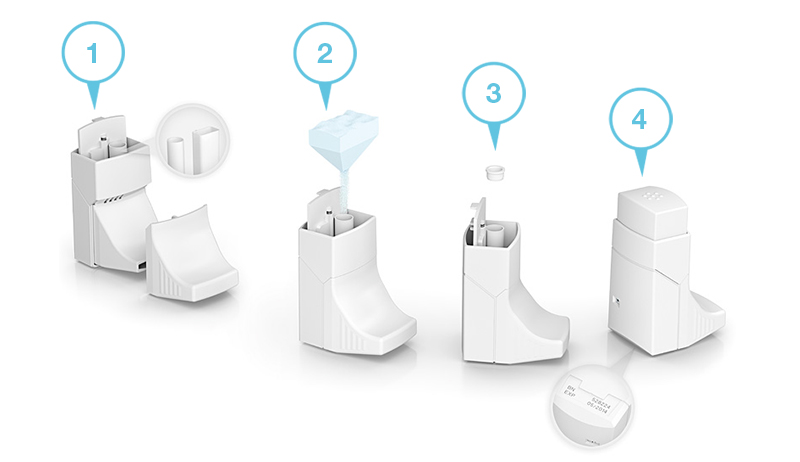China is the largest market of the so-called “pharmerging” countries and the growth of the pharmaceutical sector is even above-average in the area of respiratory therapy. The reason for this is the high level of fine dust pollution in the metropolitan areas, and the resulting respiratory diseases affecting their residents. The demand for medication is high and this trend is set to continue. Tianjin Kinnovata Pharmaceutical Company Ltd., founded in 2013, specialized early in the production and
filling of inhalers (Dry Powder Inhalers, DPI). The active ingredients contained therein in powder form are used for the treatment of respiratory diseases such as asthma or COPD (chronic obstructive pulmonary disease).
Foto:
When developing the necessary assembly and filling machines, Kinnovata deliberately banked on Harro Höfliger’s know-how and experience. The fully automatic machine delivered in May 2016 produces two inhalers per cycle and up to 40 inhalers per minute. The assembly and filling process is complex. The bottom parts of the inhaler are stored on a tray in a trayloader and fed to the assembly line just in time. All other individual parts are fed into the machine by gripper units and are gradually assembled to form complete devices. The machine has been designed in such a way that the individual parts are fed from the rear side. This makes it easier for operators and minimizes their movements.
In order to facilitate cleaning and to prevent the large-scale contamination of the entire process with active ingredient particles, the machine designers focused on and integrated the so-called walking beam transport platform: The gripper units used for assembly and transport of inhaler parts do not advance through the machine but remain at their respective assembly station.
(Photo: Harro Höfliger)
The powder is filled into both smaller round, and larger rectangular reservoirs. This is done without the need for time-consuming refitting – one of the major technical challenges that had to be overcome when designing the machine. Both fill quantities are controlled inline using weighing technology before the respective reservoir is closed with a lid. In addition, an integrated color sensor verifies the different colors of the two inhaler versions. In the next step the laser coding is applied. For this purpose, the inhalers are removed from the transport grippers, rotated over the laser and marked from below. A camera checks the quality and completeness of the marking.

Step 1: Supplying the device, Step 2: Dosing of powder, Tara weighing and Gross weighing, Step 3: Closing of reservoir, Step 4: Mounting of trigger and Laser coding
The staff and the managers at Kinnovata are very satisfied with the machine. Not only have they been convinced by the complex technology and implementation of the required process steps, but also by the seamless collaboration with Harro Höfliger. The best proof: Discussions are in progress about the manufacture of another filling and assembly line for a new generation of inhalers.
Dosing in the form of powder
Among the so-called “new administration forms”, inhalation powder is regarded as the method of choice for the intake and absorption through the lungs (pulmonary) or through the nasal mucosa (nasal). The processing of micronized powder in a fully automatic system poses a very demanding challenge in pharmaceutical production, since the processing method depends heavily on the powder’s physical properties. Particle size and geometry, size distribution as well as the surface structure of the particles affect the powder’s flow behavior.
The effect of particle size

1) Mouth and throat region, 2) Trachea Bronchial tubes, 3) Alveoli
Powder inhalers have proven to be effective for the administration of active ingredients – for example in the treatment of asthma. The graphic shows how inhalation particles are deposited in the respiratory system depending on the diameter. With its micro-dosing systems, Harro Höfliger covers a wide spectrum of conceivable particle size distributions, starting at diameters below 1 μm.
Mrs. Li, why did you choose Harro Höfliger to develop your process?

Jing li, Managing director at Tianjin Kinnovata Pharmaceutical Company ltd.
”Harro Höfliger convinced us with their technical expertise. The
machine concept they presented is excellent and fully implements our requirements. In addition, we were impressed by the numerous inhaler machines that Harro Höfliger has already implemented. This gave us the necessary assurance during our decision-making process.
But technology was not the only decisive factor. The good cooperation with Harro Höfliger and their representative Rieckermann was also crucial for our decision. And as we can now see from the flawless operation of the machine, we made the right decision.”
Download this article as PDF file
Photos: Janine Kyofsky, Helmar Lünig, Raff Digital


